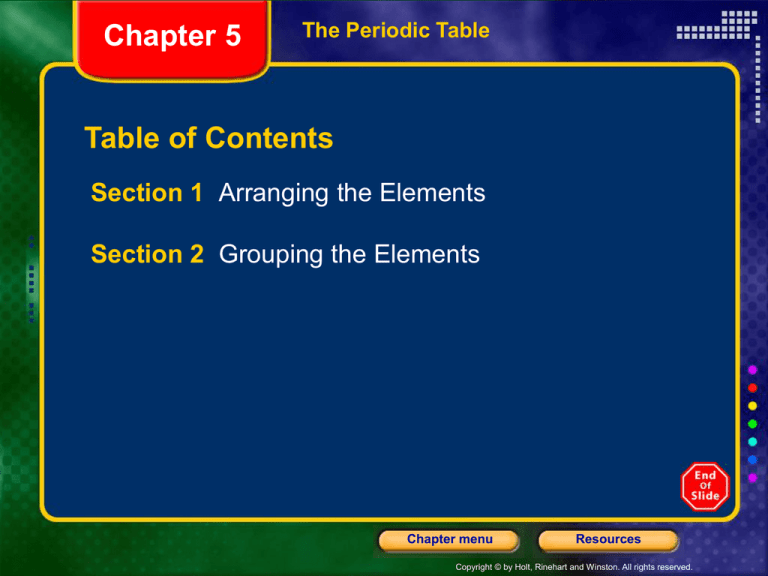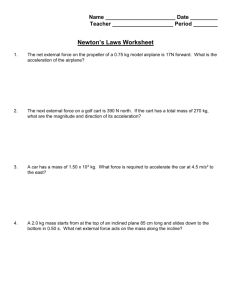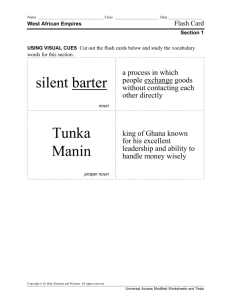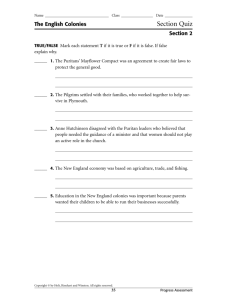
Chapter 5
The Periodic Table
Table of Contents
Section 1 Arranging the Elements
Section 2 Grouping the Elements
Chapter menu
Resources
Copyright © by Holt, Rinehart and Winston. All rights reserved.
Chapter 5
Section 1 Arranging the Elements
Objectives
• Describe how Mendeleev arranged elements in the
first periodic table.
• Explain how elements are arranged in the modern
periodic table.
• Compare metals, nonmetals, and metalloids based
on their properties and on their location in the
periodic table.
• Describe the difference between a period and a
group.
Chapter menu
Resources
Copyright © by Holt, Rinehart and Winston. All rights reserved.
Chapter 5
Section 1 Arranging the Elements
Discovering a Pattern
• In 1869, Russian chemist Dmitri Mendeleev arranged
the elements in order of increasing atomic mass.
• Periodic Properties of the Elements When the
elements are arranged in order of increasing atomic
mass, those that had similar properties occurred in a
repeating pattern.
• These repeating patterns are periodic, meaning that
they happen at regular intervals.
Chapter menu
Resources
Copyright © by Holt, Rinehart and Winston. All rights reserved.
Chapter 5
Section 1 Arranging the Elements
Discovering a Pattern, continued
• Predicting Properties of Missing Elements
Mendeleev’s arrangement had gaps in its pattern.
Mendeleev predicted that elements yet to be found
would fill these gaps. He also predicted the
properties of the missing elements.
• By 1886, all of the gaps had been filled and
Mendeleev’s predictions were right.
Chapter menu
Resources
Copyright © by Holt, Rinehart and Winston. All rights reserved.
Chapter 5
Section 1 Arranging the Elements
Changing the Arrangement
• A few elements’ properties did not fit in the pattern of
Mendeleev’s table.
• In 1914, British scientist Henry Moseley found the
number of protons—the atomic number—in an atom.
• When the elements were arranged by atomic
number, they fit the pattern in Mendeleev’s table.
Chapter menu
Resources
Copyright © by Holt, Rinehart and Winston. All rights reserved.
Chapter 5
Section 1 Arranging the Elements
Chapter menu
Resources
Copyright © by Holt, Rinehart and Winston. All rights reserved.
Chapter 5
Section 1 Arranging the Elements
The Periodic Table and Classes of Elements
• Elements are classified as metals, nonmetals, and
metalloids, according to their properties.
• The number of electrons in the outer energy level of
an atom is one characteristic that helps determine
which category an element belongs in.
• The zigzag line on the periodic table can help you
recognize which elements belong in which category.
Chapter menu
Resources
Copyright © by Holt, Rinehart and Winston. All rights reserved.
Chapter 5
Section 1 Arranging the Elements
The Periodic Table and Classes of
Elements, continued
• Metals are found to the left of the zigzag line.
Atoms of most metals have few electrons in
their outer energy level.
• Most metals are shiny, ductile, malleable, and
are good conductors of electric current and
thermal energy.
Chapter menu
Resources
Copyright © by Holt, Rinehart and Winston. All rights reserved.
Chapter 5
Section 1 Arranging the Elements
The Periodic Table and Classes of
Elements, continued
• Nonmetals are found to the right of the zigzag line.
Atoms of most nonmetals have an almost complete
set of electrons in their outer energy level.
• Nonmetals are not shiny, ductile, or malleable, and
are poor conductors of electric current and thermal
energy.
Chapter menu
Resources
Copyright © by Holt, Rinehart and Winston. All rights reserved.
Chapter 5
Section 1 Arranging the Elements
The Periodic Table and Classes of
Elements, continued
• Metalloids are the elements that border the zigzag
line. Atoms of metalloids have about half of a
complete set of electrons in their outer energy level.
• Metalloids have some properties of metals and some
properties of nonmetals.
• Metalloids are also called semiconductors.
Chapter menu
Resources
Copyright © by Holt, Rinehart and Winston. All rights reserved.
Chapter 5
Section 1 Arranging the Elements
Decoding the Periodic Table
• Each Element is Identified by a Chemical Symbol
Each square on the periodic table includes an
element’s name, chemical symbol, atomic number,
and atomic mass.
• For most elements, the chemical symbol has one or
two letters. The newest elements have temporary
three-letter symbols.
Chapter menu
Resources
Copyright © by Holt, Rinehart and Winston. All rights reserved.
Chapter 5
Section 1 Arranging the Elements
Decoding the Periodic Table, continued
• Rows Are Called Periods Each horizontal row of
elements is called a period. The chemical and
physical properties of elements in a row follow a
repeating pattern as you move across the period.
• Columns Are Called Groups Each vertical column
of elements is called a group. Elements in the same
group often have similar chemical and physical
properties.
Chapter menu
Resources
Copyright © by Holt, Rinehart and Winston. All rights reserved.
Chapter 5
Section 1 Arranging the Elements
Periodic Table Overview
Chapter menu
Resources
Copyright © by Holt, Rinehart and Winston. All rights reserved.
Chapter 5
Section 2 Grouping the Elements
Bellringer
Think about the following: How do you know that a bird
is a bird? A kangaroo is a kangaroo? A shark is a
shark? What characteristics of each animal help you
to tell them apart? How does this apply to elements?
Record your answers in your science journal.
Chapter menu
Resources
Copyright © by Holt, Rinehart and Winston. All rights reserved.
Chapter 5
Section 2 Grouping the Elements
Objectives
• Explain why elements in a group often have similar
properties.
• Describe the properties of the elements in the groups
of the periodic table.
Chapter menu
Resources
Copyright © by Holt, Rinehart and Winston. All rights reserved.
Chapter 5
Section 2 Grouping the Elements
Group 1: Alkali Metals
Alkali metals are elements in Group 1 of the
periodic table. Alkali metal properties:
•
•
•
•
group contains metals
1 electron in the outer level
very reactive
softness, color of silver, shininess, low
density
Chapter menu
Resources
Copyright © by Holt, Rinehart and Winston. All rights reserved.
Chapter 5
Section 2 Grouping the Elements
Group 2: Alkaline-Earth Metals
Alkaline-earth metals are elements in
Group 2. Alkaline-earth metal properties:
• group contains metals
• 2 electrons in the outer level
• very reactive, but less reactive than alkali
metals
• color of silver, higher densities than alkali
metals
Chapter menu
Resources
Copyright © by Holt, Rinehart and Winston. All rights reserved.
Chapter 5
Section 2 Grouping the Elements
Group 3–12: Transition Metals
• Transition metals are in Groups 3–12. Some of the
transition metals are shown below.
Chapter menu
Resources
Copyright © by Holt, Rinehart and Winston. All rights reserved.
Chapter 5
Section 2 Grouping the Elements
Group 3–12: Transition Metals, continued
Properties of Transition Metals vary widely but
include:
•
•
•
•
groups contains metals
1 or 2 electrons in the outer level
less reactive than alkaline-earth metals
shininess, good conductors of electric current and
thermal energy
Chapter menu
Resources
Copyright © by Holt, Rinehart and Winston. All rights reserved.
Chapter 5
Section 2 Grouping the Elements
Group 3–12: Transition Metals, continued
• Lanthanides and Actinides Some transition metals
from Periods 6 and 7 appear in two rows at the
bottom of the periodic table. Elements in the first row
are called lanthanides and elements in the second
row are called actinides.
Chapter menu
Resources
Copyright © by Holt, Rinehart and Winston. All rights reserved.
Chapter 5
Section 2 Grouping the Elements
Group 13: Boron Group
Aluminum is the most common element
from Group 13. Group 13 properties:
• group contains one metalloid and four
metals
• 3 electrons in the outer level
• reactive
• solids at room temperature
Chapter menu
Resources
Copyright © by Holt, Rinehart and Winston. All rights reserved.
Chapter 5
Section 2 Grouping the Elements
Group 14: Carbon Group
Group 14 properties:
• group contains one nonmetal, two
metalloids, and two metals
• 4 electrons in the outer level
• reactivity varies among the elements
• solids at room temperature
Chapter menu
Resources
Copyright © by Holt, Rinehart and Winston. All rights reserved.
Chapter 5
Section 2 Grouping the Elements
Group 15: Nitrogen Group
Group 15 properties:
• group contains two nonmetals, two
metalloids, and one metal
• 5 electrons in the outer level
• reactivity varies among the elements
• solids at room temperature (except for
nitrogen, which is a gas)
Chapter menu
Resources
Copyright © by Holt, Rinehart and Winston. All rights reserved.
Chapter 5
Section 2 Grouping the Elements
Group 16: Oxygen Group
Group 16 properties:
• group contains three nonmetals, one
metalloids, and one metal
• 6 electrons in the outer level
• reactive
• solids at room temperature (except for
oxygen, which is a gas)
Chapter menu
Resources
Copyright © by Holt, Rinehart and Winston. All rights reserved.
Chapter 5
Section 2 Grouping the Elements
Group 17: Halogens
Halogens are the elements in Group 17.
Group 17 properties:
•
•
•
•
group contains nonmetals
7 electrons in the outer level
very reactive
poor conductors of electric current, never
in uncombined form in nature
Chapter menu
Resources
Copyright © by Holt, Rinehart and Winston. All rights reserved.
Chapter 5
Section 2 Grouping the Elements
Group 18: Noble Gases
Noble gases are the elements in Group 18.
Group 18 properties:
• group contains nonmetals
• 8 electrons in the outer level (except
helium, which has 2)
• unreactive
• colorless, odorless gases at room
temperature
Chapter menu
Resources
Copyright © by Holt, Rinehart and Winston. All rights reserved.
Chapter 5
Section 2 Grouping the Elements
Hydrogen
The properties of hydrogen do not match
the properties of any single group, so
hydrogen is set apart.
•
•
•
•
a nonmetal
1 electron in the outer level
reactive
colorless, odorless gas at room
temperature, low density
Chapter menu
Resources
Copyright © by Holt, Rinehart and Winston. All rights reserved.
Chapter 5
The Periodic Table
Concept Mapping
Use the terms below to complete the concept map
on the next slide.
elements
periods
metals
electrons
nonmetals
periodic table
groups (families)
Chapter menu
Resources
Copyright © by Holt, Rinehart and Winston. All rights reserved.
Chapter 5
The Periodic Table
Chapter menu
Resources
Copyright © by Holt, Rinehart and Winston. All rights reserved.
Chapter 5
The Periodic Table
Chapter menu
Resources
Copyright © by Holt, Rinehart and Winston. All rights reserved.
End of Chapter 5 Show
Chapter menu
Resources
Chapter 5
Standardized Test Preparation
The graph below shows the densities in kilograms per
cubic meter (kg/m3) of the elements in
Period 2 of the periodic table. The densities of the
elements of Period 3 follow this trend.
Chapter menu
Resources
Copyright © by Holt, Rinehart and Winston. All rights reserved.
Chapter 5
Standardized Test Preparation
1. Which of the following elements is most likely to
have a lower density than calcium (Ca) has?
A. gallium (Ga)
B. germanium (Ge)
C. potassium (K)
D. selenium (Se)
Chapter menu
Resources
Copyright © by Holt, Rinehart and Winston. All rights reserved.
Chapter 5
Standardized Test Preparation
1. Which of the following elements is most likely to
have a lower density than calcium (Ca) has?
A. gallium (Ga)
B. germanium (Ge)
C. potassium (K)
D. selenium (Se)
Chapter menu
Resources
Copyright © by Holt, Rinehart and Winston. All rights reserved.
Chapter 5
Standardized Test Preparation
2. In Mendeleev’s periodic table, the element iodine (I)
came before tellurium (Te). He arranged the elements
by atomic weight. Later, Henry Moseley revised the
table to place iodine after tellurium. Moseley’s version
of the periodic table is still in use today. Explain the
basis for Moseley’s revision to the periodic table.
Chapter menu
Resources
Copyright © by Holt, Rinehart and Winston. All rights reserved.
Chapter 5
Standardized Test Preparation
2. Explain the basis for Moseley’s revision to the
periodic table.
Full-credit answers should include the following points:
• Moseley’s version of the periodic table is based on
atomic number.
• Some elements have higher atomic weights than
neighboring elements that have higher atomic
numbers.
• Therefore, some elements were rearranged when
atomic numbers were discovered and used to
organize the periodic table.
Chapter menu
Resources
Copyright © by Holt, Rinehart and Winston. All rights reserved.
Chapter 5
Standardized Test Preparation
The diagram below is an enlargement of a section of
the periodic table.
Chapter menu
Resources
Copyright © by Holt, Rinehart and Winston. All rights reserved.
Chapter 5
Standardized Test Preparation
3. What is the biggest difference between cobalt (Co)
and nickel (Ni) as shown in the periodic table
entries?
F. Nickel has more protons.
G. Cobalt has more electrons.
H. Cobalt has a lower number of neutrons.
I. Nickel has a higher value for atomic mass.
Chapter menu
Resources
Copyright © by Holt, Rinehart and Winston. All rights reserved.
Chapter 5
Standardized Test Preparation
3. What is the biggest difference between cobalt (Co)
and nickel (Ni) as shown in the periodic table
entries?
F. Nickel has more protons.
G. Cobalt has more electrons.
H. Cobalt has a lower number of neutrons.
I. Nickel has a higher value for atomic mass.
Chapter menu
Resources
Copyright © by Holt, Rinehart and Winston. All rights reserved.
Chapter 5
Standardized Test Preparation
The table below shows some properties of copper and
tungsten. In the table, the density of the elements are
given in grams per cubic centimeter (g/cm3). When
making coins, a large machine squashes the metal into
the coin shape.
Chapter menu
Resources
Copyright © by Holt, Rinehart and Winston. All rights reserved.
Chapter 5
Standardized Test Preparation
4. Which property of copper makes copper easier to
form into coins than tungsten?
A. lower density
B. lower hardness
C. higher reflectivity
D. higher heat conductivity
Chapter menu
Resources
Copyright © by Holt, Rinehart and Winston. All rights reserved.
Chapter 5
Standardized Test Preparation
4. Which property of copper makes copper easier to
form into coins than tungsten?
A. lower density
B. lower hardness
C. higher reflectivity
D. higher heat conductivity
Chapter menu
Resources
Copyright © by Holt, Rinehart and Winston. All rights reserved.
Chapter 5
Section 2 Grouping the Elements
Chapter menu
Resources
Copyright © by Holt, Rinehart and Winston. All rights reserved.
Chapter 5
Section 2 Grouping the Elements
Chapter menu
Resources
Copyright © by Holt, Rinehart and Winston. All rights reserved.
Chapter 5
Section 2 Grouping the Elements
Chapter menu
Resources
Copyright © by Holt, Rinehart and Winston. All rights reserved.
Chapter 5
Section 2 Grouping the Elements
Chapter menu
Resources
Copyright © by Holt, Rinehart and Winston. All rights reserved.
Chapter 5
Section 2 Grouping the Elements
Chapter menu
Resources
Copyright © by Holt, Rinehart and Winston. All rights reserved.
Chapter 5
Section 2 Grouping the Elements
Chapter menu
Resources
Copyright © by Holt, Rinehart and Winston. All rights reserved.
Chapter 5
Section 2 Grouping the Elements
Chapter menu
Resources
Copyright © by Holt, Rinehart and Winston. All rights reserved.
Chapter 5
Section 2 Grouping the Elements
Chapter menu
Resources
Copyright © by Holt, Rinehart and Winston. All rights reserved.
Chapter 5
Section 2 Grouping the Elements
Chapter menu
Resources
Copyright © by Holt, Rinehart and Winston. All rights reserved.
Chapter 5
Section 2 Grouping the Elements
Chapter menu
Resources
Copyright © by Holt, Rinehart and Winston. All rights reserved.
Chapter 5
Section 2 Grouping the Elements
Chapter menu
Resources
Copyright © by Holt, Rinehart and Winston. All rights reserved.









